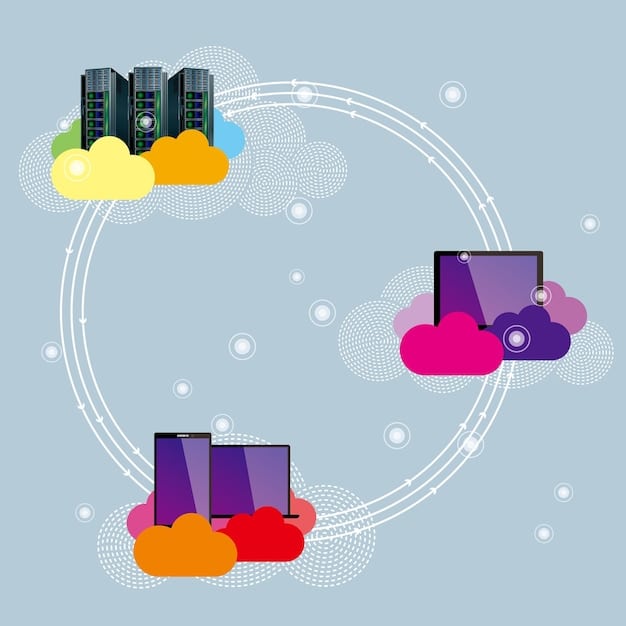US Cloud Adoption 2025: Impact on Your Business Strategy

The projected 12% increase in US cloud computing adoption by 2025 will fundamentally reshape business strategies, demanding enhanced agility, robust cybersecurity, and the strategic integration of AI to unlock new market efficiencies and competitive advantages across all sectors.
As we approach 2025, the digital landscape continues its rapid evolution, with cloud computing at its core. A projected 12% increase in US cloud computing adoption by 2025 isn’t just a statistic; it signals a profound shift that demands a proactive reassessment of your business strategy.
The foundational shift: understanding the 12% surge
The anticipated 12% surge in US cloud computing adoption is more than a mere uptick; it represents a mature market deepening its commitment to scalable, flexible, and efficient IT infrastructure. This growth isn’t uniform; it’s driven by a confluence of factors, including the pervasive need for remote work solutions, the acceleration of digital transformation initiatives, and the increasing sophistication of cloud-native applications. This collective movement signals a fundamental re-evaluation of traditional on-premise models, pushing businesses towards the inherent advantages of cloud environments.
This increased adoption is also fueled by innovations within the cloud sphere itself, particularly advancements in edge computing, serverless architectures, and specialized industry clouds. These developments are making cloud solutions more accessible and tailored to specific business needs, reducing barriers to entry and expanding the addressable market. Furthermore, the growing confidence in cloud security and compliance frameworks is alleviating past concerns, making cloud migration a more straightforward and less daunting proposition for many organizations.
Driving forces behind increased adoption
Several key factors are propelling this significant embrace of cloud technologies across the US. Understanding these drivers is crucial for any business formulating its strategic response.
- Digital Transformation Acceleration: Businesses are increasingly recognizing cloud as the necessary backbone for digital initiatives, from AI and machine learning to IoT and big data analytics.
- Remote and Hybrid Work Models: The permanence of flexible work arrangements necessitates cloud solutions for seamless collaboration, data access, and application delivery.
- Operational Efficiency and Cost Optimization: Cloud’s pay-as-you-go model and reduced infrastructure overhead offer compelling advantages for optimizing Opex over Capex.
- Enhanced Scalability and Agility: The ability to scale resources up or down on demand provides unparalleled agility in responding to market fluctuations and growth opportunities.
The cumulative effect of these drivers is creating a pervasive cloud-first mindset among US enterprises. This isn’t just about moving existing applications to the cloud; it’s about re-architecting operations and rethinking how technology can serve core business objectives more effectively and efficiently.
Furthermore, fierce competition in various sectors is pushing companies to seek out every possible advantage. Cloud computing often provides that edge, enabling faster time-to-market for new products, more personalized customer experiences, and deeper insights from data. Businesses that hesitate to embrace this shift risk falling behind agile, cloud-optimized competitors.
Strategic implications for infrastructure and operations
The rising tide of cloud adoption will fundamentally reshape how businesses architect and manage their IT infrastructure. The days of solely relying on monolithic, on-premise systems are rapidly fading, replaced by a hybrid or multi-cloud reality. This shift demands a strategic re-evaluation of infrastructure investments, operational models, and the skill sets required to manage these dynamic environments. Companies must move beyond simply “lifting and shifting” existing workloads to the cloud; instead, they need to optimize their architectures for cloud-native efficiencies.
Operations will become increasingly complex, necessitating advanced automation and intelligent orchestration tools to manage disparate cloud environments, legacy systems, and edge deployments. The focus will shift from maintaining physical servers to optimizing cloud resource utilization, managing costs, and ensuring peak performance. This transformative period calls for a move towards FinOps principles, integrating financial accountability with cloud operations to drive value and efficiency.

Adapting IT infrastructure for cloud supremacy
As cloud becomes the dominant IT paradigm, strategic infrastructure planning will involve careful consideration of hybrid and multi-cloud strategies. Businesses will need to balance the benefits of public clouds with the necessity of retaining certain workloads on-premise or in private clouds for specific compliance, security, or performance reasons.
- Hybrid Cloud Evolution: Integrating existing on-premise data centers with public cloud resources to create a seamless, cohesive IT environment. This approach allows for workload placement based on specific requirements like latency, data gravity, or regulatory compliance.
- Multi-Cloud Orchestration: Leveraging services from multiple cloud providers to gain competitive advantages, mitigate vendor lock-in, and optimize for specific workloads. Effective multi-cloud strategies require robust management tools and clear governance policies to ensure consistency and security.
- Edge Computing Integration: Pushing computational power closer to data sources at the network edge to reduce latency, conserve bandwidth, and enable real-time analytics for applications like IoT and autonomous systems. This extends the cloud’s reach and capabilities.
The operational implications are equally significant. IT teams will need to transition from traditional IT administration to cloud engineering and FinOps roles. This involves a greater focus on automation, infrastructure-as-code, and continuous optimization. Security operations will also need to evolve, with a greater emphasis on cloud-native security tools, identity and access management (IAM), and compliance automation in distributed cloud environments.
For many businesses, this also means rethinking capital expenditure. Instead of large, upfront investments in hardware, the focus shifts to operational expenditure, with continuous optimization of cloud spending becoming a core competency. This financial shift can free up capital for other strategic investments but requires disciplined cost management and forecasting.
Enhanced cybersecurity and compliance in the cloud era
With a projected 12% increase in US cloud computing adoption by 2025 comes an undeniable amplification of cybersecurity and compliance challenges. As more critical data and applications migrate to cloud environments, the attack surface expands, and the complexity of managing security across distributed infrastructures grows significantly. Businesses must evolve their security postures from perimeter-based defenses to a more dynamic, data-centric approach, prioritizing robust access controls, encryption, and continuous monitoring throughout the cloud ecosystem.
Compliance also becomes a more intricate dance. Industries are subject to evolving regulations (such as HIPAA, GDPR, CCPA, and sector-specific mandates), and ensuring adherence in multi-cloud or hybrid environments requires diligent planning and sophisticated tooling. The shared responsibility model inherent in cloud computing means that while cloud providers handle the security *of* the cloud, businesses are ultimately responsible for security *in* the cloud—a distinction often overlooked, leading to significant vulnerabilities.
Navigating the cybersecurity landscape
The dynamic nature of cloud environments necessitates a proactive and adaptive cybersecurity strategy. Traditional security measures may not suffice; instead, organizations must embrace cloud-native security tools and methodologies.
- Identity and Access Management (IAM): Implementing granular access controls and multi-factor authentication (MFA) to ensure that only authorized individuals and services can access cloud resources. Misconfigured IAM is a leading cause of cloud breaches.
- Data Encryption and Loss Prevention: Encrypting data both at rest and in transit, coupled with robust data loss prevention (DLP) solutions, is crucial for protecting sensitive information across all cloud deployments.
- Cloud Security Posture Management (CSPM): Utilizing automated tools to continuously monitor cloud configurations against security benchmarks and compliance standards, identifying and remediating misconfigurations in real-time.
Beyond these technical considerations, a strong security culture within the organization is paramount. Employee training on cloud security best practices, phishing awareness, and responsible data handling can significantly reduce human error, a common vector for cyberattacks. Furthermore, establishing clear incident response plans tailored to cloud environments is essential for rapid detection and mitigation of threats.
The integration of AI and machine learning into security operations is also gaining traction, enabling the detection of anomalies and potential threats that might escape traditional signature-based systems. This proactive threat intelligence is vital for staying ahead of sophisticated cyber adversaries in an increasingly interconnected cloud world.
Achieving compliance in a multi-cloud world
Compliance is no longer a checklist item but an ongoing strategic imperative. The increased adoption of cloud services introduces complexities that demand a comprehensive and automated approach to regulatory adherence.
- Automated Compliance Tools: Leveraging tools that provide continuous auditing, reporting, and automated remediation of non-compliant configurations ensures ongoing adherence to industry-specific and general data protection regulations.
- Regulatory Mapping and Data Governance: Clearly defining where sensitive data resides across various cloud services and mapping it against relevant regulatory requirements to inform data retention, residency, and access policies.
- Vendor Due Diligence: Thoroughly vetting cloud service providers (CSPs) for their compliance certifications (e.g., ISO 27001, SOC 2, FedRAMP) and ensuring their security practices align with your organization’s risk appetite and regulatory obligations.
The unique challenge of multi-cloud compliance lies in harmonizing disparate security controls and reporting mechanisms across different providers. Businesses need a unified view of their compliance posture, often achieved through cloud security platforms that aggregate data and provide centralized dashboards. Regular third-party audits and certifications are also critical to demonstrate ongoing compliance and build trust with stakeholders and customers.
Understanding the nuances of data sovereignty and cross-border data transfer regulations is particularly important for businesses operating globally, even if their primary market is the US. The increasing adoption of cloud means data can easily traverse geographical boundaries, making adherence to diverse legal frameworks a complex but necessary undertaking.
The imperative of skill development and talent acquisition
The projected 12% increase in US cloud computing adoption by 2025 will inevitably exacerbate the existing talent gap in cloud-related skills. Businesses that fail to strategically invest in upskilling their current workforce and aggressively recruiting new talent will find themselves at a severe competitive disadvantage. The demand for cloud architects, DevOps engineers, FinOps specialists, and cloud security experts is already soaring, and this trend is set to intensify, making talent acquisition a top strategic priority.
This isn’t merely about filling technical roles; it’s about fostering a culture of continuous learning and adaptation. As cloud technologies evolve at a breakneck pace, the skills considered essential today may be outdated tomorrow. Therefore, companies must move beyond traditional reactive training models to proactive, integrated learning pathways that allow employees to acquire and refine cloud competencies iteratively.
Bridging the cloud skills gap
Addressing the cloud skills shortage requires a multi-pronged approach that combines internal development with external recruitment efforts. Businesses must recognize that this is an investment in their future resilience and innovation capacity.
- Internal Upskilling Programs: Developing structured training programs, certifications, and mentorship initiatives for existing IT staff to transition into cloud-focused roles. This empowers current employees and reduces the need for constant external hiring.
- Partnerships with Educational Institutions: Collaborating with universities and technical colleges to help shape cloud curricula, ensuring graduates possess the practical skills needed by businesses. Internships and apprenticeships can also serve as effective talent pipelines.
- Certification and Specialization: Encouraging employees to obtain industry-recognized cloud certifications (e.g., AWS Certified Solutions Architect, Azure Administrator Associate, Google Cloud Professional Cloud Architect) to validate their expertise.
Beyond formal training, creating internal communities of practice, where cloud professionals can share knowledge and best practices, can significantly accelerate skill development. Gamification and project-based learning can also make the upskilling process more engaging and effective, ensuring practical application of theoretical knowledge.
Retention of highly skilled cloud talent is also crucial. Competitive compensation, opportunities for challenging work, a supportive learning environment, and a clear career progression path are key factors in retaining these valuable employees who are constantly sought after in the market.
Strategic talent acquisition
As the demand for cloud experts outstrips supply, aggressive and thoughtful talent acquisition strategies are essential. Relying solely on traditional recruitment methods will likely prove insufficient.
- Employer Branding for Cloud Talent: Positioning the company as a leader in cloud innovation and a desirable place for cloud professionals to work, highlighting growth opportunities and cutting-edge projects.
- Global Talent Sourcing: Expanding recruitment efforts beyond local markets to tap into a wider pool of international cloud talent, potentially leveraging remote work models to attract top-tier expertise regardless of location.
- Recruitment Specialization: Partnering with recruitment agencies that specialize in cloud and tech talent, or building an internal recruitment team with deep understanding of cloud roles and the relevant skill sets.
The interview process for cloud roles should move beyond theoretical knowledge to practical, hands-on assessments. Utilizing coding challenges, architecture design exercises, and real-world problem-solving scenarios can provide a clearer picture of a candidate’s actual capabilities and their ability to integrate into the team’s working style. Focusing on soft skills like problem-solving, adaptability, and collaboration is also critical, as cloud environments require constant iteration and teamwork.
Furthermore, consider unconventional talent pools, such as veterans or individuals from non-traditional tech backgrounds, who possess strong analytical and problem-solving skills that can be adapted to cloud roles with the right training and mentorship programs. This broadens the talent search and promotes diversity within cloud teams.
Shifting cost structures and financial planning
The projected 12% increase in US cloud computing adoption by 2025 significantly alters traditional IT cost structures, moving from capital expenditure (CapEx) to operational expenditure (OpEx). While often perceived as a cost-saving measure, cloud adoption introduces new complexities in financial oversight and optimization. Without robust FinOps practices, businesses can quickly find their cloud spending spiraling out of control, negating potential savings. Strategic financial planning must evolve to encompass dynamic cloud consumption models, real-time cost visibility, and continuous optimization efforts.
This shift requires strong collaboration between finance, IT, and business units to align cloud spending with business value. It’s not just about reducing costs but about maximizing the return on cloud investments. Companies must implement tools and processes that provide deep insights into cloud resource utilization, enabling them to make informed decisions about resource allocation, rightsizing, and identifying areas of inefficiency.
Embracing FinOps for cloud cost optimization
FinOps, a cultural practice that brings financial accountability to the variable spend model of cloud, becomes indispensable in managing cloud costs effectively. It’s an ongoing process of optimization, not a one-time event.
- Cost Visibility and Allocation: Implementing tools to monitor cloud spend in real-time, tag resources effectively for cost allocation to specific teams or projects, and generate detailed cost reports. This provides transparency and clarifies who is responsible for what spending.
- Resource Optimization: Regularly analyzing resource usage to identify opportunities for rightsizing (adjusting instance types), eliminating idle resources, and leveraging auto-scaling features to match demand.
- Discount Mechanisms: Strategically utilizing cloud provider discount options like reserved instances, savings plans, and spot instances for predictable workloads to achieve significant savings.
The success of FinOps largely depends on cultural alignment. Breaking down silos between engineering, finance, and business teams is critical to ensure that everyone understands the financial implications of their cloud usage. Regular communication and shared goals centered around cloud value creation are key to effective FinOps implementation.
Furthermore, establishing cloud cost governance policies—including budget alerts, automation for stopping unused resources, and clear guidelines for provisioning new services—can help prevent unexpected expenditure and maintain financial discipline. This proactive approach to cost management distinguishes successful cloud transformations from those challenged by runaway bills.
Rethinking investment priorities
With cloud becoming a dominant force, businesses must re-evaluate where they allocate their financial resources. The shift away from large CapEx investments in data centers frees up capital for other strategic areas.
- Innovation and R&D: Redirecting funds previously tethered to infrastructure maintenance towards developing new cloud-native products, services, and advanced analytics capabilities.
- Employee Training and Development: Investing in upskilling the workforce to manage and innovate within cloud environments, recognizing that human capital is now a primary digital asset.
- Cybersecurity Enhancements: Allocating more resources to cloud-specific security tools, threat intelligence, and compliance automation, ensuring data protection in a decentralized landscape.
The flexibility of cloud-based OpEx models also allows businesses to experiment more freely with new technologies and initiatives. The lower upfront costs and ability to scale down quickly reduce the financial risk associated with pioneering new ventures, fostering a more agile and innovative corporate culture. This responsiveness is a significant competitive advantage in rapidly evolving markets.
However, it also requires a shift in how financial performance is measured. Traditional IT budgeting cycles may need to be adjusted to accommodate the dynamic nature of cloud spending, with a greater emphasis on continuous forecasting and agile budgeting practices that reflect real-time consumption patterns. This financial agility mirrors the operational agility offered by the cloud itself.
Innovation and competitive advantage through cloud-native capabilities
The projected 12% increase in US cloud computing adoption by 2025 isn’t just about infrastructure; it’s a direct catalyst for innovation and a crucial determinant of competitive advantage. Businesses that strategically embrace cloud-native development and leverage advanced cloud services will unlock unprecedented opportunities for agility, scalability, and market differentiation. This means moving beyond simply hosting applications in the cloud to truly building applications that exploit the cloud’s inherent benefits, such as serverless computing, microservices, and managed AI/ML services.
Cloud-native approaches enable faster development cycles, continuous deployment, and the ability to iterate rapidly based on market feedback. Furthermore, the ready availability of powerful, pre-built cloud services for areas like data analytics, artificial intelligence, and machine learning democratizes access to cutting-edge technologies, allowing even smaller businesses to compete with larger enterprises on innovation.
Unlocking new business models and services
Cloud adoption facilitates the emergence of novel business models and the rapid development of innovative services. The flexibility and scalability of cloud environments lower the barrier to entry for experimentation and product launch.
- PaaS and Serverless Architectures: Utilizing Platform as a Service (PaaS) and serverless computing allows developers to focus purely on code logic, abstracting away infrastructure management and accelerating time-to-market for new applications and features.
- Data-Driven Insights: Leveraging cloud-based big data analytics and machine learning services to extract deeper insights from customer data, optimize operations, personalize experiences, and predict market trends.
- Global Reach and Localization: Cloud’s global infrastructure enables businesses to easily expand into new geographical markets, delivering localized services with minimal latency and high availability.
The ability to integrate various cloud services via APIs also fosters innovation through composability. Businesses can stitch together different components to create bespoke solutions without building every piece from scratch, leading to more agile and cost-effective development. This encourages a partner ecosystem approach, where companies can leverage specialized third-party cloud services to enhance their offerings.
Furthermore, cloud-native development often goes hand-in-hand with adopting DevOps practices, which streamline the entire software development lifecycle, from coding and testing to deployment and monitoring. This continuous feedback loop and automation further accelerate innovation and improve product quality, providing a significant competitive edge.
Gaining a competitive edge through agility
In today’s fast-paced market, agility is paramount. Cloud computing directly contributes to a business’s ability to respond quickly to market changes, seize new opportunities, and outmaneuver competitors.
- Rapid Prototyping and Deployment: Cloud environments allow businesses to spin up resources on demand, test new ideas, and deploy applications rapidly, reducing the time from concept to market.
- Scalability for Demand Fluctuation: The elastic nature of cloud resources means businesses can seamlessly scale their infrastructure up during peak demand and down during off-peak times, optimizing costs and maintaining performance without over-provisioning.
- Resilience and Disaster Recovery: Cloud’s distributed nature and built-in redundancy features enhance business continuity and disaster recovery capabilities, ensuring uninterrupted service delivery even in the face of disruptions.
This inherent agility allows businesses to iterate on their products and services faster than competitors relying on traditional IT infrastructures. They can gather customer feedback, push out updates, and even pivot their strategies with greater ease. This responsiveness translates directly into enhanced customer satisfaction and market share. The continuous integration and continuous delivery (CI/CD) pipelines enabled by cloud further embed this agility into the development process.
Moreover, the cloud’s access to a vast ecosystem of third-party tools and services means businesses can integrate best-of-breed solutions without significant upfront investment. This fosters a highly adaptable technology stack that can evolve with market demands, rather than being constrained by legacy systems and infrastructure limitations. The net result is a highly responsive, competitive enterprise.
Future-proofing your business: AI, machine learning and beyond
The projected 12% increase in US cloud computing adoption by 2025 sets the stage for the mainstream integration of advanced technologies like Artificial Intelligence (AI) and Machine Learning (ML). These capabilities, once exclusive to large enterprises with significant compute resources, are now democratized through cloud platforms. For businesses, this means that future-proofing their strategies goes beyond simply migrating to the cloud; it involves strategically leveraging cloud-native AI/ML services to drive intelligence across operations, customer engagement, and product development. Those who embrace these integrated capabilities will forge a significant competitive advantage, while those who lag may find their relevance diminished.
Beyond AI/ML, the cloud also facilitates the exploration of emerging technologies such as quantum computing, blockchain, and advanced simulation. While these are still nascent for many businesses, their foundational reliance on scalable, on-demand compute resources points directly to the cloud as their primary enabling environment. Strategic planning now must consider how to build a flexible enough cloud infrastructure to accommodate these future innovations, ensuring long-term adaptability.
Integrating AI and ML for business intelligence
Cloud platforms offer a suite of managed AI and ML services that simplify the development, deployment, and scaling of intelligent applications. This accessibility transforms how businesses can derive insights and automate processes.
- Predictive Analytics for Decision Making: Using ML models to forecast trends, predict customer behavior, manage inventory, and optimize resource allocation, leading to more informed and proactive business decisions.
- Personalized Customer Experiences: Implementing AI-powered chatbots, recommendation engines, and sentiment analysis tools to deliver highly personalized interactions and improve customer satisfaction and loyalty.
- Operational Automation and Optimization: Applying AI to automate routine tasks, optimize supply chains, enhance quality control, and improve energy efficiency, leading to significant cost savings and operational improvements.
The true power of cloud-based AI lies not just in the models themselves, but in their ability to process vast amounts of data from diverse sources at scale. This enables enterprises to uncover hidden patterns and insights that would be impossible with traditional analytical methods. Furthermore, the continuous learning capabilities of cloud AI services mean that models can adapt and improve over time, enhancing their accuracy and effectiveness.
Businesses that integrate AI strategically will also find themselves in a better position to innovate their products and services. For example, embedded AI can lead to smarter products with enhanced features, while AI-driven research and development can accelerate the discovery of new solutions. This deep integration is what truly future-proofs a business.
Preparing for future technological shifts
The cloud’s inherent flexibility and scalability make it the ideal foundation for embracing future technological shifts. Businesses can leverage cloud infrastructure to experiment with and adopt emerging trends without massive upfront investments.
- Quantum Computing Experimentation: Accessing quantum computing simulators and early-stage quantum hardware via cloud platforms to explore potential applications in optimization, drug discovery, or financial modeling.
- Blockchain as a Service (BaaS): Utilizing cloud-based blockchain platforms to build and deploy distributed ledger technology applications for supply chain transparency, secure transactions, or digital identity management.
- Spatial Computing and Extended Reality (XR): Leveraging cloud compute for rendering complex 3D environments, supporting virtual reality (VR), augmented reality (AR), and mixed reality applications that require significant processing power, often edge-based.
Building a future-ready business means fostering an environment of continuous exploration and adaptation. The cloud provides the sandbox for this, allowing companies to test new technologies at a lower risk and scale them quickly if they prove valuable. This agility in adopting bleeding-edge innovations will define market leaders in the coming decade.
Additionally, the cloud’s robust API ecosystems and developer tools empower organizations to integrate diverse technologies seamlessly. This interoperability ensures that businesses are not locked into proprietary solutions but can build modular, adaptable systems that can evolve as new technologies emerge. This strategic foresight ensures that the investment in cloud computing today yields dividends in long-term innovation and resilience.
| Key Area | Strategic Impact |
|---|---|
| ⚙️ Infrastructure | Shift to hybrid/multi-cloud, requiring advanced management for agility and cost-efficiency. |
| 🔒 Cybersecurity & Compliance | Increased complexity demands data-centric security, robust IAM, and automation for regulatory adherence. |
| 🧠 Talent Development | Critical need for upskilling current staff, aggressive recruitment of cloud-native experts. |
| 🚀 Innovation | Enables faster product development, new business models, and integration of AI/ML for competitive edge. |
Frequently asked questions
▼
For small businesses, this projection signifies that cloud technologies will become even more ubiquitous and integrated into daily operations. It means increased access to powerful tools once reserved for large enterprises, enabling competitive scalability, enhanced collaboration, and potentially lower IT overheads. However, it also implies stronger competition from cloud-optimized rivals, necessitating a proactive and specific cloud strategy to remain relevant and efficient.
▼
The surge will heighten the importance of robust cloud cybersecurity. While cloud providers secure the cloud infrastructure itself, your business remains responsible for securing your data and applications within that cloud. This necessitates stronger identity and access management, data encryption, regular security audits, and continuous monitoring. A solid understanding of the shared responsibility model is crucial to avoiding vulnerabilities and ensuring compliance with evolving data protection regulations.
▼
Not automatically. While cloud computing offers the potential for significant cost savings by shifting from capital expenditure to operational expenditure, achieving these savings requires active management. Without proper FinOps practices, resource optimization, and continuous monitoring of usage, cloud costs can quickly escalate. Strategic planning, coupled with disciplined cost visibility and allocation, is essential to realize the intended financial benefits and prevent unexpected expenses.
▼
As cloud adoption grows, there will be increased demand for cloud architects, DevOps engineers, FinOps specialists, and cloud-focused cybersecurity professionals. Beyond technical roles, skills in data analytics, AI/ML integration, and agile project management will become increasingly valuable. Businesses should invest in continuous learning programs, certifications, and cross-functional training to upskill their existing workforce and attract new talent familiar with cloud-native methodologies.
▼
Leveraging the cloud increase for competitive advantage means embracing cloud-native development and advanced services. Focus on rapid prototyping, leveraging AI/ML for deeper insights and personalization, and using serverless architectures for agility. Cloud enables faster time-to-market for new products, enhanced global scalability, and resilience. Businesses that align their cloud strategy with core innovation goals will lead, while those merely using cloud as an IT cost-saving measure may fall behind.
Conclusion
The projected 12% increase in US cloud computing adoption by 2025 is more than a trend; it’s a strategic mandate. Its ripple effects will touch every facet of business operations, from infrastructure and cybersecurity to financial planning, talent development, and innovation capacity. Companies that proactively adapt their strategies—by investing in resilient hybrid cloud architectures, fortifying cloud security postures, upskilling their workforce, embracing robust FinOps practices, and leveraging cloud-native AI/ML capabilities—will not only navigate this shift successfully but emerge stronger and more competitive. The future of business is intrinsically linked to the cloud, demanding foresight, agility, and a continuous commitment to evolution.





